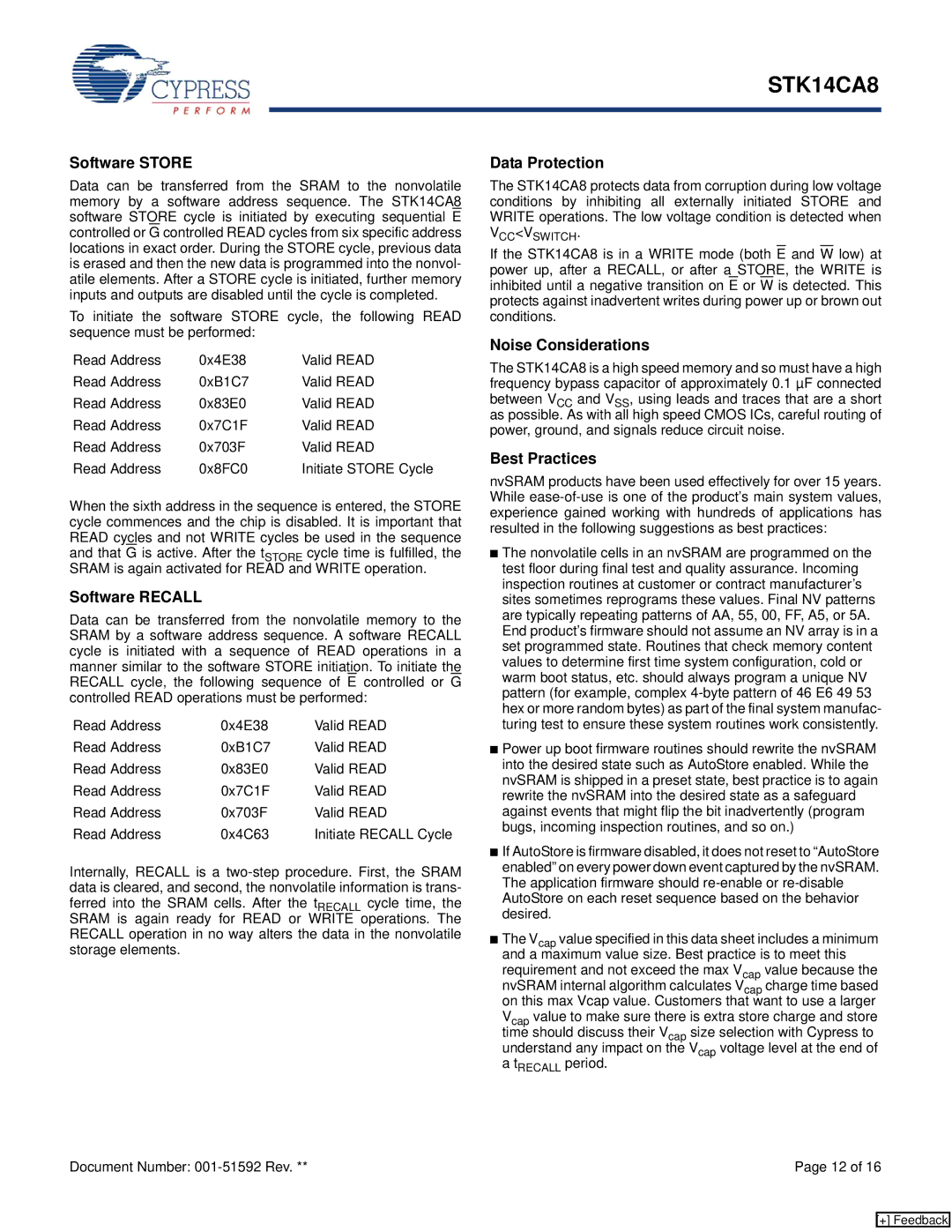
STK14CA8
Software STORE
Data can be transferred from the SRAM to the nonvolatile memory by a software address sequence. The STK14CA8 software STORE cycle is initiated by executing sequential E controlled or G controlled READ cycles from six specific address locations in exact order. During the STORE cycle, previous data is erased and then the new data is programmed into the nonvol- atile elements. After a STORE cycle is initiated, further memory inputs and outputs are disabled until the cycle is completed.
To initiate the software STORE cycle, the following READ sequence must be performed:
Read Address | 0x4E38 | Valid READ |
Read Address | 0xB1C7 | Valid READ |
Read Address | 0x83E0 | Valid READ |
Read Address | 0x7C1F | Valid READ |
Read Address | 0x703F | Valid READ |
Read Address | 0x8FC0 | Initiate STORE Cycle |
When the sixth address in the sequence is entered, the STORE cycle commences and the chip is disabled. It is important that READ cycles and not WRITE cycles be used in the sequence and that G is active. After the tSTORE cycle time is fulfilled, the SRAM is again activated for READ and WRITE operation.
Software RECALL
Data can be transferred from the nonvolatile memory to the SRAM by a software address sequence. A software RECALL cycle is initiated with a sequence of READ operations in a manner similar to the software STORE initiation. To initiate the RECALL cycle, the following sequence of E controlled or G controlled READ operations must be performed:
Read Address | 0x4E38 | Valid READ |
Read Address | 0xB1C7 | Valid READ |
Read Address | 0x83E0 | Valid READ |
Read Address | 0x7C1F | Valid READ |
Read Address | 0x703F | Valid READ |
Read Address | 0x4C63 | Initiate RECALL Cycle |
Internally, RECALL is a
Data Protection
The STK14CA8 protects data from corruption during low voltage conditions by inhibiting all externally initiated STORE and WRITE operations. The low voltage condition is detected when
VCC<VSWITCH.
If the STK14CA8 is in a WRITE mode (both E and W low) at power up, after a RECALL, or after a STORE, the WRITE is inhibited until a negative transition on E or W is detected. This protects against inadvertent writes during power up or brown out conditions.
Noise Considerations
The STK14CA8 is a high speed memory and so must have a high frequency bypass capacitor of approximately 0.1 µF connected between VCC and VSS, using leads and traces that are a short as possible. As with all high speed CMOS ICs, careful routing of power, ground, and signals reduce circuit noise.
Best Practices
nvSRAM products have been used effectively for over 15 years. While
■The nonvolatile cells in an nvSRAM are programmed on the test floor during final test and quality assurance. Incoming inspection routines at customer or contract manufacturer’s sites sometimes reprograms these values. Final NV patterns are typically repeating patterns of AA, 55, 00, FF, A5, or 5A. End product’s firmware should not assume an NV array is in a set programmed state. Routines that check memory content values to determine first time system configuration, cold or warm boot status, etc. should always program a unique NV pattern (for example, complex
■Power up boot firmware routines should rewrite the nvSRAM into the desired state such as AutoStore enabled. While the nvSRAM is shipped in a preset state, best practice is to again rewrite the nvSRAM into the desired state as a safeguard against events that might flip the bit inadvertently (program bugs, incoming inspection routines, and so on.)
■If AutoStore is firmware disabled, it does not reset to “AutoStore enabled” on every power down event captured by the nvSRAM. The application firmware should
■The Vcap value specified in this data sheet includes a minimum and a maximum value size. Best practice is to meet this requirement and not exceed the max Vcap value because the nvSRAM internal algorithm calculates Vcap charge time based on this max Vcap value. Customers that want to use a larger Vcap value to make sure there is extra store charge and store time should discuss their Vcap size selection with Cypress to understand any impact on the Vcap voltage level at the end of a tRECALL period.
Document Number: | Page 12 of 16 |
[+] Feedback
